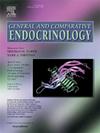The S6 kinase gene in the fruit fly, Drosophila melanogaster, is essential for metabolic regulation
IF 1.7
3区 医学
Q3 ENDOCRINOLOGY & METABOLISM
引用次数: 0
Abstract
The S6 kinase (S6K) enzyme phosphorylates the S6 ribosomal protein, promoting protein translation and growth. Here we investigated in flies whether hypomorphic conditions in S6K affect intermediate metabolism and oxidative homeostasis, besides carbohydrates and growth. We also employed partial activation of the nuclear factor 2 erythroid related factor 2 (Nrf2) in a S6K hypomorphic background and controls. S6K is activated by the target of rapamycin (TOR) kinase, a key kinase regulating metabolism, downstream of the insulin receptor in flies. The insulin pathway is a general anabolic pathway, and key regulator of glucose homeostasis. The Nrf2 counters pro-oxidative conditions, also involved in inflammatory responses and metabolism. The Nrf2 fly homolog is Cap’n’collar C (CncC). We quantified glucose, glycogen, and total lipids in control and different pro-oxidative conditions. We corroborated an accumulation of lipids and carbohydrates in the mutants, and document sexual differences. We document also metabolic and survival differences in the responses to “mild” pro-oxidative conditions in young flies (seven days old), with females being most affected. We compare 10 mM paraquat survival of virgin flies to mated mixed-sex flies housed together. We used females to study transcriptomic differences between wild type and S6k hypomorphs. Results highlight dysregulation of lipid and antioxidant enzymes and genes, in agreement with lipid and oxidative metabolism data. Our results are consistent with the insulin/TOR pathway acting as an integrator of intermediate metabolism and oxidative homeostasis (this last together with the CncC pathway).
果蝇(Drosophila melanogaster)体内的S6激酶基因对代谢调节至关重要。
S6激酶(S6K)酶磷酸化S6核糖体蛋白,促进蛋白质翻译和生长。在此,我们在果蝇中研究了S6K的半形状态是否影响中间代谢和氧化稳态,除了碳水化合物和生长。我们还在S6K亚型背景和对照中部分激活核因子2红细胞相关因子2 (Nrf2)。S6K被雷帕霉素激酶(TOR)靶点激活,雷帕霉素激酶是调节代谢的关键激酶,位于果蝇胰岛素受体的下游。胰岛素途径是一般的合成代谢途径,是葡萄糖稳态的关键调节因子。Nrf2对抗促氧化条件,也参与炎症反应和代谢。Nrf2苍蝇的同源物是Cap'n'collar C (CncC)。我们在对照和不同促氧化条件下定量葡萄糖、糖原和总脂质。我们证实了突变体中脂质和碳水化合物的积累,并记录了性别差异。我们还记录了幼蝇(7天大)对“轻度”促氧化条件反应的代谢和生存差异,其中雌性受影响最大。我们比较了10 mM百草枯存活的处女苍蝇和交配混性苍蝇一起饲养。我们用雌性来研究野生型和S6k亚型之间的转录组学差异。结果强调了脂质和抗氧化酶和基因的失调,与脂质和氧化代谢数据一致。我们的研究结果与胰岛素/TOR途径作为中间代谢和氧化稳态的整合者(最后一个与CncC途径一起)是一致的。
本文章由计算机程序翻译,如有差异,请以英文原文为准。
求助全文
约1分钟内获得全文
求助全文
来源期刊

General and comparative endocrinology
医学-内分泌学与代谢
CiteScore
5.60
自引率
7.40%
发文量
120
审稿时长
2 months
期刊介绍:
General and Comparative Endocrinology publishes articles concerned with the many complexities of vertebrate and invertebrate endocrine systems at the sub-molecular, molecular, cellular and organismal levels of analysis.
 求助内容:
求助内容: 应助结果提醒方式:
应助结果提醒方式:


